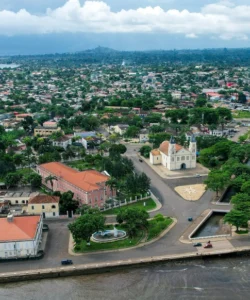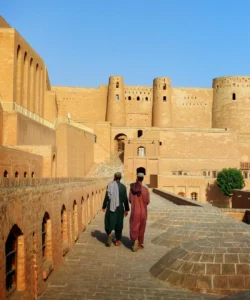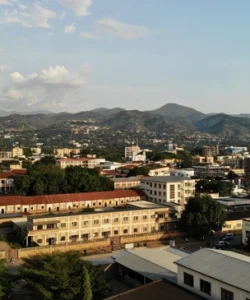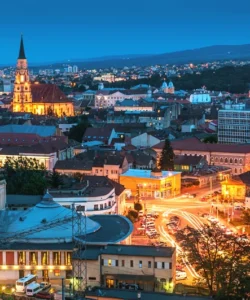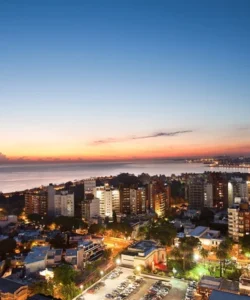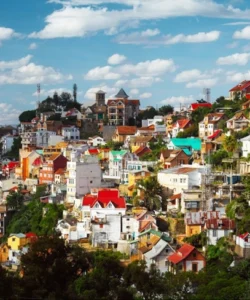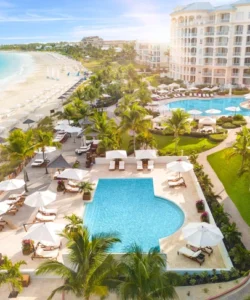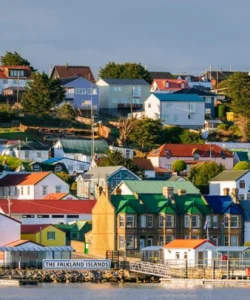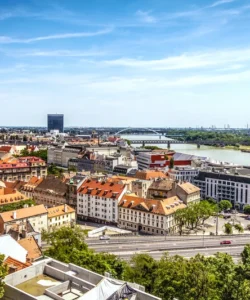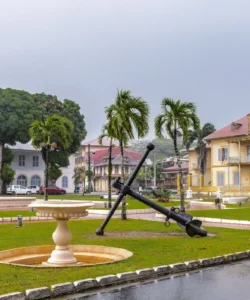Slovenia, officially the Republic of Slovenia, is a country in Central Europe, bordering Italy, Austria, Hungary, and Croatia, with a short coastline on the Adriatic Sea. It is a country of remarkable natural beauty, from the Julian Alps to the Adriatic coast, known for its pristine forests, picturesque lakes, charming towns, and a unique blend of Central European and Mediterranean cultures.
Area and Population:
Slovenia covers an area of approximately 20,273 km² (7,827 sq mi). As of early 2025, its population is estimated to be around 2.12 million inhabitants.
Capital:
The capital city of Slovenia is Ljubljana.
Major Cities:
Besides Ljubljana, other major cities include Maribor, Celje, Kranj, and Koper.
Language:
The official language of Slovenia is Slovene (Slovenščina). In ethnically mixed areas, Italian and Hungarian are also co-official. English is widely understood, especially among younger generations and in tourist areas.
Currency:
As a member of the European Union, Slovenia uses the Euro (€) as its official currency.
Religion:
The dominant religion in Slovenia is Roman Catholicism, with the majority of the population identifying as Catholic. There are smaller communities of Orthodox Christians, Muslims, and other religious groups. A significant percentage of the population identifies as non-religious or atheist.
Attractions and Wonders:
- Lake Bled: Slovenia’s most iconic natural attraction, featuring a picturesque island with a church in the middle of a turquoise lake, surrounded by mountains and crowned by a medieval castle perched on a cliff. You can take a traditional “pletna” boat to the island.
- Ljubljana Old Town: The charming capital city with its pedestrianized streets, Baroque architecture, Dragon Bridge, Triple Bridge, and a medieval castle overlooking the city.
- Postojna Cave: One of the world’s most extensive cave systems, famous for its unique underground railway ride and incredible stalactite and stalagmite formations. It’s also home to the proteus (human fish).
- Predjama Castle: A dramatic medieval castle built within the mouth of a cave, seamlessly integrated into the rock face, making it appear almost impenetrable.
- Triglav National Park: Slovenia’s only national park, encompassing most of the Julian Alps, home to Mount Triglav (Slovenia’s highest peak), stunning valleys (e.g., Soča Valley), pristine lakes (Lake Bohinj), and diverse wildlife, offering superb hiking and outdoor activities.
- Lake Bohinj: A larger, more tranquil glacial lake than Bled, located within Triglav National Park, offering excellent opportunities for swimming, hiking, and water sports.
- Piran: A picturesque medieval coastal town on the Adriatic, often compared to Venice, with narrow streets, a beautiful main square, and a Venetian-style bell tower.
- Julian Alps: A stunning mountain range offering dramatic peaks, emerald rivers (like the Soča River), and numerous outdoor adventure opportunities.
- Vintgar Gorge: A beautiful natural gorge near Bled, with wooden walkways winding alongside the Radovna River, leading to a waterfall.
- Škocjan Caves: Another UNESCO World Heritage site, a massive and awe-inspiring underground canyon system.
- Logar Valley (Logarska Dolina): A stunning glacial valley in the Kamnik-Savinja Alps, known for its waterfalls, hiking trails, and traditional farms.
Architecture:
Slovenian architecture is a blend of Central European (Austro-Hungarian) influences, especially in its cities, and traditional Alpine styles.
- Ljubljana’s Unique Style: Shaped significantly by the architect Jože Plečnik in the early 20th century, giving the city a distinctive look with features like the Triple Bridge, the Central Market, and the National and University Library. It blends classical elements with a unique, often monumental, vision.
- Medieval and Baroque: Evident in old town centers like Ljubljana, Piran, and Maribor, with charming squares, churches, and historic buildings.
- Austro-Hungarian: Many buildings in Ljubljana and other cities from the late 19th and early 20th centuries reflect grand Art Nouveau and Secessionist styles.
- Alpine Architecture: Traditional wooden or stone chalets and farmhouses in the mountainous regions, designed to withstand the climate.
- Socialist-era Architecture: Some functionalist buildings from the Yugoslav period, particularly in residential areas.
- Contemporary: Modern architectural projects are emerging, especially in urban areas, balancing functionality with aesthetic appeal.
Roads:
Slovenia has a modern and efficient road network, making travel within the country and to neighboring states very convenient.
- Motorways (Avtoceste – A-roads): An excellent system of multi-lane, well-maintained highways (marked with “A” numbers on green signs) connects major cities and provides crucial links to Austria, Italy, Hungary, and Croatia. A vignette (road tax sticker) is mandatory for all vehicles using motorways.
- Expressways (Hitre Ceste – H-roads): Similar to motorways but usually with two lanes (one in each direction), often serving as major regional routes.
- Main Roads (Glavne Ceste – G-roads): A comprehensive network of well-maintained national roads (marked with “G” numbers on yellow signs) connects towns and regions not on the motorways. These are often scenic.
- Regional Roads: Smaller roads providing access to villages and rural areas, generally in good condition.
- Mountain Roads: Roads in the Julian Alps and other mountainous regions can be winding and steep, requiring caution, especially in winter due to snow.
- Signage: Road signs are clear and generally in Slovene.
Driving is an ideal way to explore Slovenia’s diverse landscapes, offering flexibility to visit its natural wonders.
Hotels:
Slovenia offers a diverse range of accommodation options, from luxurious resorts to charming boutique hotels and traditional farm stays.
- Luxury and 5-Star Hotels: Found in Ljubljana, Lake Bled, and some spa towns, offering high-end amenities and services.
- Boutique Hotels: Numerous charming and stylish boutique hotels are available, particularly in Ljubljana and the picturesque old towns.
- Wellness and Spa Hotels: Slovenia is known for its thermal spas, and many hotels in these regions offer extensive wellness facilities.
- Rural Tourism (Turistične Kmetije): Farm stays are a fantastic option, especially in the countryside and wine regions, offering authentic experiences, local food, and often activities like hiking or cycling.
- Guesthouses (Gostišča) and Apartments: Many smaller, family-run establishments and self-catering apartments provide a cozy and often affordable stay.
- Mountain Huts (Koče): Essential for hikers in the Alps, offering basic but welcoming accommodation.
- Campsites: Available in many natural areas, from lakeside to mountain settings.
Restaurants and Cuisine:
Slovenian cuisine is a delightful blend of Central European (Austrian, Hungarian), Balkan, and Mediterranean (Italian, Croatian) influences, with strong regional variations and a focus on fresh, local, and seasonal ingredients.
- Idrijski Žlikrofi: A type of dumpling, often filled with potatoes, onions, and minced lard or bacon, typically served with a rich meat sauce (bakalca). A Protected Geographical Indication dish.
- Kranjska Klobasa: A traditional Carniolan sausage, a type of semi-smoked sausage made from pork, bacon, garlic, and pepper. A PGI product.
- Potica: A traditional Slovenian festive roll cake, made with a thin yeast dough and various fillings (walnut is the most common, but also tarragon, poppy seed, honey, etc.).
- Prekmurska Gibanica: A layered pastry cake from the Prekmurje region, with four different fillings (poppy seeds, walnuts, apples, and cottage cheese). A PGI product.
- Jota: A hearty stew, particularly popular in the western regions, made with sauerkraut or turnip, beans, potatoes, and often smoked pork.
- Štruklji: A versatile dish of rolled dough with various sweet or savory fillings (cottage cheese, walnuts, apple, tarragon), boiled or baked.
- Ajdovi žganci (Buckwheat Spoonbread): A hearty side dish made from buckwheat flour, often served with sour milk or cracklings.
- Rižota (Risotto): Influenced by Italian cuisine, various risotto dishes are popular, often with mushrooms or seafood.
- Fresh Fish and Seafood: Especially along the short coast, grilled fish and seafood dishes are common.
- Wild Mushrooms: Abundant in Slovenian forests and frequently used in local dishes.
- Pršut and Kraški ovčji sir: Karst prosciutto (air-dried ham) and local sheep cheese from the Karst region.
Drinks:
- Wine: Slovenia has three main wine-growing regions (Podravje, Posavje, and Primorska), producing excellent white and red wines. Varieties include Rebula, Malvazija, Furmint (Šipon), and Blaufränkisch (Modra Frankinja).
- Beer: Popular local lagers include Laško and Union. Craft beer scene is growing.
- Schnapps (Žganje): Various fruit brandies, often homemade (e.g., Slivovka – plum brandy, Sadjevec – fruit brandy).
- Mineral Water: Slovenia is rich in natural mineral waters, including the famous Radenska.
Dining in Slovenia offers a range from cozy “gostilnas” (traditional inns) and pizzerias to modern fine dining restaurants, especially in Ljubljana and the popular tourist areas. The emphasis on seasonality and fresh, local produce is a hallmark of Slovenian cuisine.

